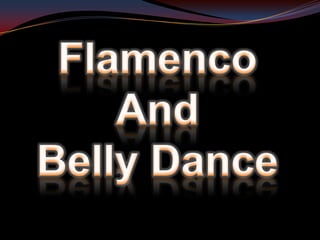Belly Dance And Flamenco
- 3. Flamenco
- 4. Whatisthe flamenco?Flamenco is a style of music which is considered part of the culture of Spain
- 5. Is a folk art in SourthSpain
- 6. Flamenco musicstyles are called “palos”
- 7. Flamenco dance has complexpatterns of rhythm and sophisticatedfootworkwiththeupperbodyemphasisinggrace and posture.
- 8. Dressing in a flamenco style:
- 9. For rehearsals: It is sufficient to wear a rehearsal skirt, a maillot (vest or jersey) and shoes, in discrete colours.
- 10. For dancing on a stage: The wardrobe in a theatre depends on the choreographies, on the dance companies and on fashion trends. In the past the dresses were heavier, because they carried cancans, and their colours.For popular feasts: if will need a folk dressIn thewasactivity:Finallythereisthetheatricalpresentation of flamenco, which uses flamenco technique and musicbutiscloser in presentationto a ballet performance, withmusicians in theorchestra, scenery, lighting etc. Flamenco artists can befound in thefollowcategories: Flamenco singers. Flamenco guitarists. Flamenco dancers.
- 11. Also, the flamenco dance has complexpatterns of rhythm and sophisticatedfootworkwiththeupperbodyemphasisinggrace and posture.
- 12. Belly Dance
- 13. The term "Belly dance" is a misnomer as all parts of the body are involved in the dance; the most featured body part in raqssharqi being the hips. Belly dance takes many different forms depending on country and region, both in costume and dance style;; and new styles have been invented in the West as its popularity has spread globally.
- 14. Itdevelopedthroughtheinfluence of manydifferentcultures.itsorigin in theGreek.Isvery popular in theregions of Arabian, Egypt and northAfrica.
- 15. Strengthening, reshaping and renewedacceptance of one'sbody.Greaterfreedom of selfexpression.Relieffrom back pain.Familiaritywithdifferent musical styles and culturesSpending time foryourself.Beneficts:
- 16. Esta fue unas de las actividades a las que asistĂ en la semana multicultural. AprendĂ muchas costumbres y tradiciones de otros paĂses.










